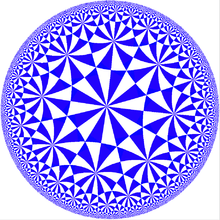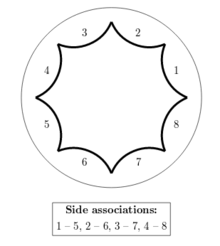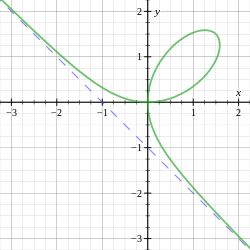Bolza surface
In mathematics, the Bolza surface, alternatively, complex algebraic Bolza curve (introduced by Oskar Bolza (1887)), is a compact Riemann surface of genus 2 with the highest possible order of the conformal automorphism group in this genus, namely GL2(3) of order 48. The full automorphism group (including reflections) is the semi-direct product of order 96. An affine model for the Bolza surface can be obtained as the locus of the equation
in . The Bolza surface is the smooth completion of the affine curve. Of all genus 2 hyperbolic surfaces, the Bolza surface maximizes the length of the systole (Schmutz 1993). As a hyperelliptic Riemann surface, it arises as the ramified double cover of the Riemann sphere, with ramification locus at the six vertices of a regular octahedron inscribed in the sphere, as can be readily seen from the equation above.
The Bolza surface has attracted the attention of physicists, as it provides a relatively simple model for quantum chaos; in this context, it is usually referred to as the Hadamard–Gutzwiller model.[1] The spectral theory of the Laplace–Beltrami operator acting on functions on the Bolza surface is of interest to both mathematicians and physicists, since the surface is conjectured to maximize the first positive eigenvalue of the Laplacian among all compact, closed Riemann surfaces of genus 2 with constant negative curvature.
Triangle surface

The Bolza surface is a (2,3,8) triangle surface – see Schwarz triangle. More specifically, the Fuchsian group defining the Bolza surface is a subgroup of the group generated by reflections in the sides of a hyperbolic triangle with angles . The group of orientation preserving isometries is a subgroup of the index-two subgroup of the group of reflections, which consists of products of an even number of reflections, which has an abstract presentation in terms of generators and relations as well as . The Fuchsian group defining the Bolza surface is also a subgroup of the (3,3,4) triangle group, which is a subgroup of index 2 in the (2,3,8) triangle group. The (2,3,8) group does not have a realization in terms of a quaternion algebra, but the (3,3,4) group does.
Under the action of on the Poincare disk, the fundamental domain of the Bolza surface is a regular octagon with angles and corners at
where . Opposite sides of the octagon are identified under the action of the Fuchsian group. Its generators are the matrices
where and , along with their inverses. The generators satisfy the relation

These generators are connected to the length spectrum. First,
where is the length of the systole. All other geodesics in the spectrum take the form
where , runs through the natural numbers (apart from 48 and 72) (Aurich, Bogomolny & Steiner 1991). Here is the unique odd number that minimises
It is possible to obtain an equivalent closed form of the systole length directly from the triangle group. Formulae exist to calculate the side lengths of a (2,3,8) triangles explicitly. The systole is equal to four times the length of the side of medial length in a (2,3,8) triangle, that is,
The systole also appears in the Fenchel–Nielsen coordinates of the surface; in particular, one set of coordinates is
There is also a "symmetric" set of coordinates where all the length parameters are given by the systole, and have equal twist parameters, namely
Symmetries of the surface

The fundamental domain of the Bolza surface is a regular octagon in the Poincaré disk; the four symmetric actions that generate the (full) symmetry group are:
- R – rotation of order 8 about the centre of the octagon;
- S – reflection in the real line;
- T – reflection in the side of one of the 16 (4,4,4) triangles that tessellate the octagon;
- U – rotation of order 3 about the centre of a (4,4,4) triangle.
These are shown by the bold lines in the adjacent figure. They satisfy the following set of relations:
where is the trivial (identity) action. One may use this set of relations in GAP to retrieve information about the representation theory of the group. In particular, there are four 1-dimensional, two 2-dimensional, four 3-dimensional, and three 4-dimensional irreducible representations. Indeed, these values satisfy Burnside's lemma, that is
which is the order of the group (including reflections) as expected.
Spectral theory

Here, spectral theory refers to the spectrum of the Laplacian, . The first eigenspace (that is, the eigenspace corresponding to the first positive eigenvalue) of the Bolza surface is three-dimensional, and the second, four-dimensional (Cook 2018), (Jenni 1981). It is thought that investigating perturbations of the nodal lines of functions in the first eigenspace in Teichmüller space will yield the conjectured result in the introduction. This conjecture is based on extensive numerical computations of eigenvalues of the surface and other surfaces of genus 2. In particular, the spectrum of the Bolza surface is known to a very high accuracy (Strohmaier & Uski 2013). The following table gives the first ten positive eigenvalues of the Bolza surface.
| Eigenvalue | Numerical value | Multiplicity |
|---|---|---|
| 0 | 1 | |
| 3.8388872588421995185866224504354645970819150157 | 3 | |
| 5.353601341189050410918048311031446376357372198 | 4 | |
| 8.249554815200658121890106450682456568390578132 | 2 | |
| 14.72621678778883204128931844218483598373384446932 | 4 | |
| 15.04891613326704874618158434025881127570452711372 | 3 | |
| 18.65881962726019380629623466134099363131475471461 | 3 | |
| 20.5198597341420020011497712606420998241440266544635 | 4 | |
| 23.0785584813816351550752062995745529967807846993874 | 1 | |
| 28.079605737677729081562207945001124964945310994142 | 3 | |
| 30.833042737932549674243957560470189329562655076386 | 4 |
The spectral determinant and Casimir energy of the Bolza surface are
and
respectively, where all decimal places are believed to be correct. It is conjectured that the spectral determinant is maximized in genus 2 for the Bolza surface.
Quaternion algebra
Following MacLachlan and Reid, the quaternion algebra can be taken to be the algebra over generated as an associative algebra by generators i,j and relations
with an appropriate choice of an order.
See also
References
- Bolza, Oskar (1887), "On Binary Sextics with Linear Transformations into Themselves", American Journal of Mathematics, 10 (1): 47–70, doi:10.2307/2369402, JSTOR 2369402
- Katz, M.; Sabourau, S. (2006). "An optimal systolic inequality for CAT(0) metrics in genus two". Pacific J. Math. 227 (1): 95–107. arXiv:math.DG/0501017. doi:10.2140/pjm.2006.227.95.
- Schmutz, P. (1993). "Riemann surfaces with shortest geodesic of maximal length". GAFA. 3 (6): 564–631. doi:10.1007/BF01896258.
- Aurich, R.; Bogomolny, E.B.; Steiner, F. (1991). "Periodic orbits on the regular hyperbolic octagon". Physica D: Nonlinear Phenomena. 48 (1): 91–101. Bibcode:1991PhyD...48...91A. doi:10.1016/0167-2789(91)90053-C.
- Cook, J. (2018). Properties of Eigenvalues on Riemann Surfaces with Large Symmetry Groups (PhD thesis, unpublished). Loughborough University.
- Jenni, F. (1981). Ueber das Spektrum des Laplace-Operators auf einer Schar kompakter Riemannscher Flachen (PhD thesis). University of Basel.
- Strohmaier, A.; Uski, V. (2013). "An Algorithm for the Computation of Eigenvalues, Spectral Zeta Functions and Zeta-Determinants on Hyperbolic Surfaces". Communications in Mathematical Physics. 317 (3): 827–869. arXiv:1110.2150. Bibcode:2013CMaPh.317..827S. doi:10.1007/s00220-012-1557-1.
- Maclachlan, C.; Reid, A. (2003). The Arithmetic of Hyperbolic 3-Manifolds. Graduate Texts in Math. 219. New York: Springer. ISBN 0-387-98386-4.
- Specific
- ↑ Aurich, R.; Sieber, M.; Steiner, F. (1 August 1988). "Quantum Chaos of the Hadamard–Gutzwiller Model". Physical Review Letters. 61 (5): 483–487. Bibcode:1988PhRvL..61..483A. doi:10.1103/PhysRevLett.61.483.
